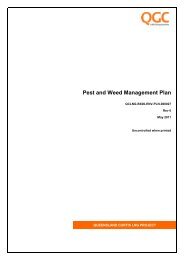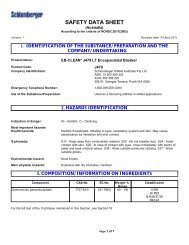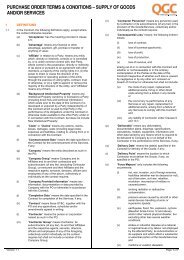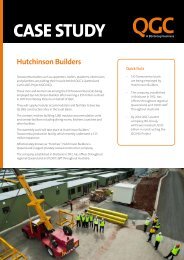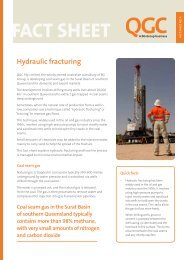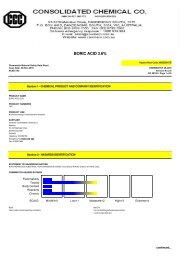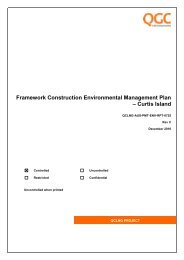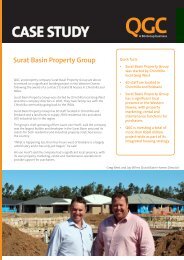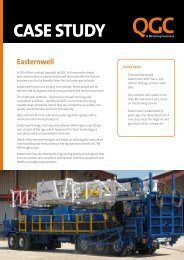Ecological Management Plan for LNG Facility Preclearing ... - QGC
Ecological Management Plan for LNG Facility Preclearing ... - QGC
Ecological Management Plan for LNG Facility Preclearing ... - QGC
Create successful ePaper yourself
Turn your PDF publications into a flip-book with our unique Google optimized e-Paper software.
<strong>Ecological</strong> <strong>Management</strong> <strong>Plan</strong> <strong>for</strong><br />
<strong>LNG</strong> <strong>Facility</strong> <strong>Preclearing</strong> Activities<br />
September 2010<br />
Reptiles and Amphibians<br />
Pit-fall traps, spotlighting and day-searching <strong>for</strong> amphibians and reptiles was conducted on-site during<br />
October 2008. Traps were placed across the site in order to sample a representative range of habitats. In<br />
total, pit-fall trapping ef<strong>for</strong>t equated to 69 trap-days.<br />
4.1.3 Field Surveys – Supplementary EIS<br />
Additional bird assessments were undertaken during September 2009 and involved a range of surveying<br />
techniques including nocturnal surveys, call broadcasting, habitat assessment, shoreline surveys, dusk<br />
surveys and tree surveys. A larger study area, including Curtis Island and the mainland, was investigated<br />
compared to previous surveys to assess the cumulative impact of other developments, to place the subject<br />
site in a local context and to identify potential reference sites should monitoring be required.<br />
The draft EIS identified the presence of at least one pair of Powerful Owls (listed as Vulnerable under the<br />
Nature Conservation Act 1992 (NC Act)) whose home range includes the area proposed <strong>for</strong> the <strong>LNG</strong><br />
<strong>Facility</strong>. Further surveys of this species were there<strong>for</strong>e undertaken to identify possible roosting and nesting<br />
locations within the site and the surrounding area.<br />
In conjunction with a revised assessment of terrestrial ecology impacts associated with the revised Project<br />
description, this additional data was used to provide an updated assessment of impacts on these species,<br />
as well as to provide a basis <strong>for</strong> additional management and mitigation measures.<br />
4.2 Existing Environment<br />
4.2.1 Topography<br />
The <strong>LNG</strong> <strong>Facility</strong> site has an elevation between 10 m and 25 m Australian Height Datum (AHD) throughout<br />
the majority of the site. The site rises from sea level (along its western boundary) up to more than 80 m<br />
near the eastern site boundary. The <strong>LNG</strong> <strong>Facility</strong> footprint, is located within a basin-like structure with hills<br />
on the southern, northern and western boundaries.<br />
4.2.2 Soils<br />
The dominant underlying geology of the study area is the Wandilla Formation of the Curtis Island Group<br />
consisting of mudstone, quartz greywacke, and pale grey chert. The estuary environments associated with<br />
Graham Creek and Port of Gladstone consist of Holocene sediments of gravel, silt and clay alluvium and<br />
associated mangrove swamps, mud flats and salt pans.<br />
No parts of the study area have been listed on either the Queensland Environmental <strong>Management</strong> Register<br />
(EMR) or Contaminated Land Register (CLR). Further detail on site geology, including acid sulfate soils<br />
(ASS), is provided in Volume 5, Chapter 4 of the EIS.<br />
4.2.3 Drainage and Waterways<br />
No permanent freshwater bodies are known to be present within the study area. Surface hydrology on<br />
Curtis Island is characterised by annual stream flow as a product of sub-tropical seasonal rainfall. Further<br />
detail is provided in Volume 5, Chapter 9 of the EIS.<br />
Two main ephemeral watercourses flow from north-east to south-west through the <strong>LNG</strong> <strong>Facility</strong>. There are<br />
several smaller first and second order ephemeral watercourses flowing into the main creeks from the<br />
elevated areas on the south and north of the site. The creeks observed across the site generally range in<br />
16 of 43




